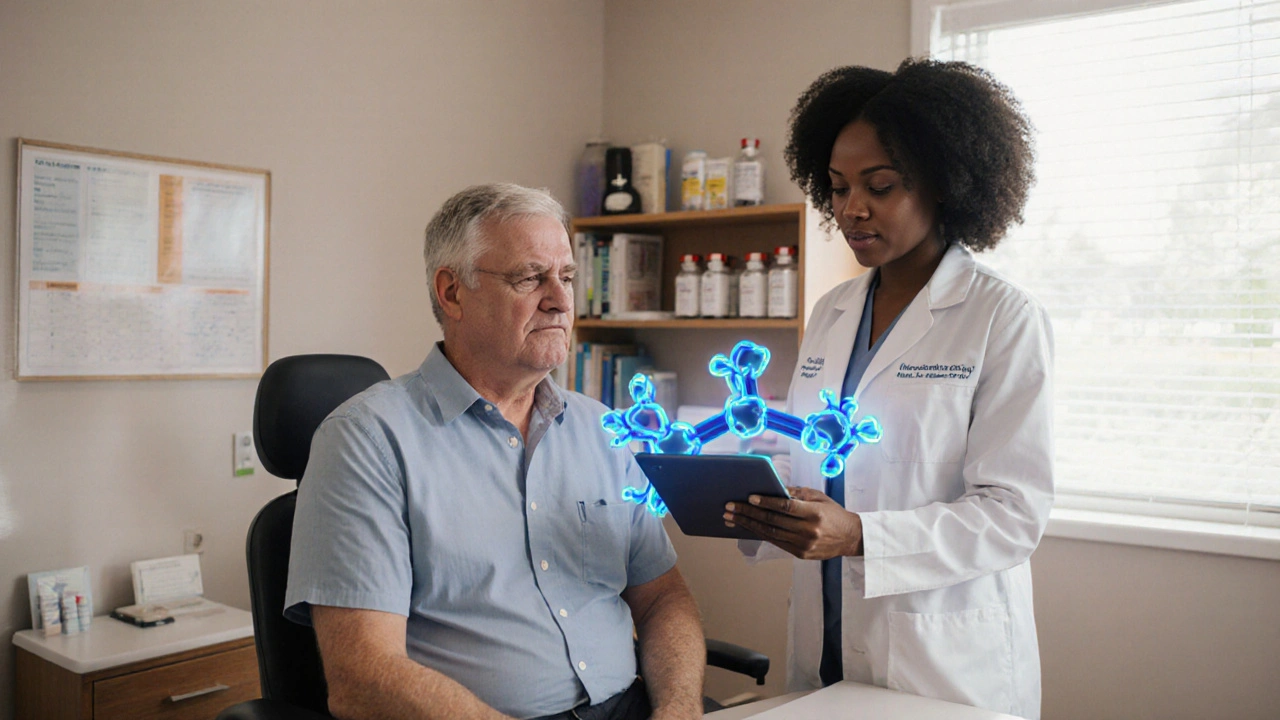Blood Pressure Medication Selector
Select your health conditions and preferences to get a personalized medication recommendation.
Quick Take
- Doxazosin is an alpha‑1 blocker used for hypertension and BPH.
- Common alternatives include prazosin, terazosin, amlodipine and lisinopril.
- Mechanisms vary: alpha‑1 blockade vs calcium‑channel blockade vs ACE inhibition.
- Side‑effect profiles differ - dizziness and first‑dose syncope are most common with Doxazosin.
- Choosing the right drug depends on blood‑pressure goals, prostate symptoms, and tolerance of side effects.
If you’re deciding whether Doxazosin is right for you, consider the points below. This guide breaks down how Doxazosin works, compares it head‑to‑head with the most frequently prescribed alternatives, and offers a practical decision framework.
What is Doxazosin?
Doxazosin is an oral alpha‑1 adrenergic receptor blocker that relaxes smooth muscle in blood vessels and the prostate. Approved in 1995, it treats both hypertension and benign prostatic hyperplasia (BPH). By preventing norepinephrine from tightening arterial walls, it lowers peripheral resistance and improves urine flow in men with enlarged prostates.
How Doxazosin Works
The drug belongs to the alpha‑1 blocker class. It binds selectively to alpha‑1 receptors on vascular smooth muscle, causing vasodilation. In the prostate, the same receptor blockade reduces smooth‑muscle tone, easing urinary obstruction. Because the effect is dose‑dependent, clinicians start with a low dose (1mg) and titrate up to a typical maximum of 16mg daily.
Key Alternatives to Consider
Below are the most common drugs that people switch to or combine with Doxazosin.
Prazosin
Prazosin is another alpha‑1 blocker, often prescribed for hypertension and off‑label for PTSD‑related nightmares. Its dosing ranges from 1mg three times daily to 5mg three times daily. Side effects mirror Doxazosin (dizziness, headache) but it is less commonly used for BPH.
Terazosin
Terazosin shares the same class as Doxazosin, targeting both hypertension and BPH. Typical doses start at 1mg nightly and may reach 10mg. Compared with Doxazosin, terazosin has a slightly higher incidence of orthostatic hypotension, especially in elderly patients.
Amlodipine
Amlodipine is a calcium‑channel blocker. It relaxes arterial smooth muscle by inhibiting calcium influx, lowering blood pressure without affecting prostate tissue. Standard dosing is 5-10mg once daily. Common side effects include peripheral edema and, rarely, gum overgrowth.
Lisinopril
Lisinopril belongs to the ACE inhibitor class. It reduces angiotensin‑II production, leading to vasodilation and decreased aldosterone. Doses range from 5mg to 40mg daily. While effective for hypertension and heart failure, a persistent dry cough and elevated potassium levels are frequent complaints.
Hypertension
Hypertension (high blood pressure) affects roughly 1.13billion people worldwide. Management often requires a combination of lifestyle changes and medication, with the choice of drug guided by comorbidities such as BPH, diabetes, or chronic kidney disease.
Benign Prostatic Hyperplasia (BPH)
Benign Prostatic Hyperplasia is a non‑cancerous enlargement of the prostate gland, leading to urinary urgency, weak stream, and nocturia. Alpha‑1 blockers like Doxazosin and Terazosin are first‑line pharmacologic options because they quickly improve symptoms.

Side‑Effect Snapshot
Understanding the safety profile helps you weigh options. The table below highlights the most clinically relevant adverse events for each drug.
| Medication | Class | Typical Dose | Primary Uses | Major Side Effects |
|---|---|---|---|---|
| Doxazosin | Alpha‑1 blocker | 1‑16mg daily | Hypertension, BPH | Dizziness, first‑dose syncope, edema |
| Prazosin | Alpha‑1 blocker | 1‑5mg three times daily | Hypertension, PTSD nightmares | Dizziness, headache, nasal congestion |
| Terazosin | Alpha‑1 blocker | 1‑10mg nightly | Hypertension, BPH | Orthostatic hypotension, dizziness |
| Amlodipine | Calcium‑channel blocker | 5‑10mg daily | Hypertension, angina | Peripheral edema, gum overgrowth, flushing |
| Lisinopril | ACE inhibitor | 5‑40mg daily | Hypertension, heart failure | Dry cough, hyperkalemia, angio‑edema |
Pros and Cons of Doxazosin vs Each Alternative
Compared to Prazosin
- Pros: Longer half‑life (≈22h) allows once‑daily dosing; also treats BPH.
- Cons: Higher risk of first‑dose syncope; prazosin’s shorter action can be easier to titrate for PTSD.
Compared to Terazosin
- Pros: Slightly lower incidence of nocturnal hypotension; more flexible dosing (up to 16mg).
- Cons: Terazosin is cheaper in many markets and has a similar symptom‑relief profile.
Compared to Amlodipine
- Pros: Directly improves urinary flow for BPH patients, something amlodipine can’t do.
- Cons: Amlodipine causes less dizziness and is often better tolerated in the elderly.
Compared to Lisinopril
- Pros: No dry cough; works well when kidney function is reduced.
- Cons: ACE inhibitors provide additional cardio‑protective benefits that alpha‑blockers lack.
How to Choose the Right Medication
Consider these decision criteria:
- Primary health issue: If BPH symptoms dominate, an alpha‑1 blocker (Doxazosin or Terazosin) is logical. For isolated hypertension without prostate concerns, a calcium‑channel blocker or ACE inhibitor may be preferable.
- Side‑effect tolerance: Patients prone to dizziness should steer clear of high‑dose Doxazosin.
- Cost and insurance coverage: Generic terazosin and lisinopril are often cheaper than branded Doxazosin.
- Comorbidities: Diabetes or chronic kidney disease may favor ACE inhibitors; heart failure benefits from lisinopril.
- Drug interactions: Doxazosin can potentiate other antihypertensives, raising the risk of hypotension when combined.
Discuss these factors with your clinician; they can tailor a regimen that balances efficacy, safety, and cost.
Practical Tips & Common Pitfalls
- Start with the lowest dose (1mg) and take it at bedtime to blunt first‑dose syncopal episodes.
- Monitor blood pressure and heart rate after the first week; adjust upward only if readings stay above target.
- Stay hydrated, especially when standing up quickly, to reduce orthostatic dizziness.
- Report persistent cough or swelling promptly - it may indicate a need to switch classes.
- Avoid grapefruit juice with amlodipine; it can raise drug levels and increase side effects.
Frequently Asked Questions
Can Doxazosin be used alone for high blood pressure?
Yes, many patients achieve target blood pressure with Doxazosin monotherapy, especially when BPH symptoms are also present. However, clinicians often add a thiazide diuretic or ACE inhibitor if the response is insufficient.
Why does the first dose cause dizziness?
The initial dose can cause a sudden drop in peripheral resistance, leading to a brief drop in blood pressure (orthostatic hypotension). Taking the first tablet at bedtime and starting at 1mg mitigates this effect.
Is Doxazosin safe for people with diabetes?
Generally, yes. It does not affect blood glucose levels. Still, monitor for low blood pressure, especially if you’re on insulin or other antihypertensives.
How quickly does Doxazosin improve urinary flow?
Patients often notice relief within 3‑5 days, with maximal benefit after 2‑4 weeks as the prostate smooth muscle relaxes fully.
Should I avoid alcohol while on Doxazosin?
Alcohol can amplify the blood‑pressure‑lowering effect, increasing dizziness risk. Moderate consumption is usually fine, but avoid binge drinking.



When you look at the big picture, Doxazosin offers a nice blend of blood pressure control and prostate relief. It’s especially helpful for folks who are juggling both hypertension and BPH without adding extra pills. Starting low and going slow is the key – the first dose can make you feel light‑headed if you’re not careful. Many patients find that taking it at night eases that “first‑dose” dip. Overall, it’s a solid option when you need that dual action.
Honestly, this guide hits most of the practical points – 👍 the dosing tips, side‑effect alerts, and the comparison table are super handy. I love how it flags the first‑dose syncopal risk; that’s a real‑world concern many forget to mention 😅. The emoji‑friendly tone makes the heavy info a bit lighter, and the layout is easy on the eyes. If you’re on Doxazosin or considering a switch, this read gives you a clear roadmap.
Doxazosin works by blocking alpha‑1 receptors on blood vessels and the prostate, which relaxes smooth muscle and lowers pressure. This dual action makes it unique among antihypertensives because it also helps urinary flow. Starting at a low dose, usually 1 mg at bedtime, reduces the risk of first‑dose orthostatic hypotension. Patients should be told to rise slowly from sitting or lying positions for the first few weeks. Blood pressure should be checked after the first week and then weekly until stable. If the target is not met, the dose can be titrated up by 1 mg increments every 2–4 weeks. Doxazosin is metabolized in the liver and does not require dose adjustment for mild to moderate renal impairment. However, severe kidney disease may still need careful monitoring because of potential drug accumulation. Common side effects include dizziness, headache, and occasional edema, which often improve with dose adjustment. Unlike ACE inhibitors, Doxazosin does not cause a persistent dry cough. This can be advantageous for patients who are sensitive to that side effect. In patients with heart failure, the drug does not have proven mortality benefit, so an ACE inhibitor or ARB is usually preferred. For those with both hypertension and BPH, Doxazosin can simplify the medication regimen, reducing pill burden. Cost can be higher than generic terazosin, so insurance coverage should be checked. Always counsel patients to avoid sudden alcohol intake because it can amplify the blood‑pressure‑lowering effect. Finally, regular follow‑up visits allow the clinician to assess symptom relief and adjust therapy as needed.
The pharmacodynamic profile here is spot‑on: alpha‑1 blockade yields vasodilation while concurrently decreasing prostatic smooth‑muscle tone. From a mechanistic standpoint, Doxazosin edges out prazosin when BPH symptomatology is a priority, albeit at a modestly higher cost index. Terazosin’s half‑life is slightly shorter, which could translate to reduced nocturnal hypotension in geriatric cohorts. Calcium‑channel antagonists like amlodipine bypass the prostate entirely, making them suboptimal for dual‑purpose therapy. ACE inhibitors, on the other hand, bring renoprotective benefits but introduce the dreaded dry cough, a trade‑off many patients cannot tolerate.
i totally get ur point about the bedtime dosing – it’s a game changer for avoiding that dizzy feeling. also, the cost thing can be a real headache, lol. if u’re looking for cheaper alternatives, terazosin is often covered better by insurence. just remember to bump the dose slowly, especially if you’re older.
While the advice to start low is sound, it would be prudent to emphasize the importance of patient education regarding orthostatic symptoms. A brief reminder to monitor blood pressure at home can prevent unnecessary ER visits. Also, noting that the drug is hepatically cleared helps when assessing polypharmacy.
Great, another drug that makes you feel like you’re on a roller coaster.
Those follow‑up tips are spot on. Regular visits let you catch any lingering dizziness early, and they give a chance to adjust the dose before side effects become intolerable. It’s also a good moment to reassess the overall cardiovascular risk profile.
When weighing Doxazosin against its peers, consider both the clinical goals and the patient’s lifestyle. If urinary symptoms dominate, an alpha‑blocker is logical; if the focus is purely on blood pressure, a calcium‑channel blocker or ACE inhibitor might be smoother. Side‑effect tolerance, especially dizziness, often dictates the final pick. Cost and formulary status can also tip the balance in routine practice. Ultimately, shared decision‑making ensures the chosen regimen aligns with the individual’s preferences.
i agree with the emphasis on shared decision‑making – it’s essential to tailor therapy to each patient’s unique context. also, dont forget to screen for orthostatic hypotension before titrating up; it can save a lot of trouble later on.